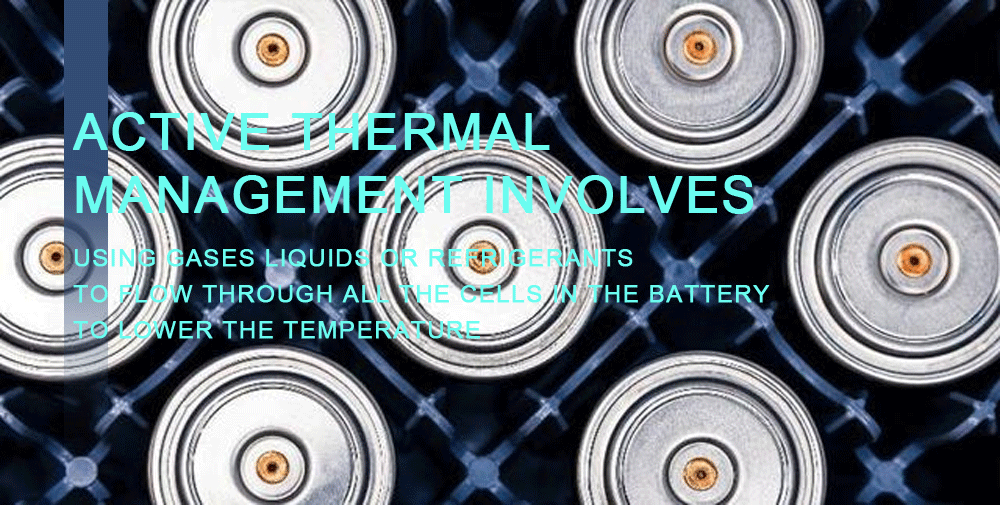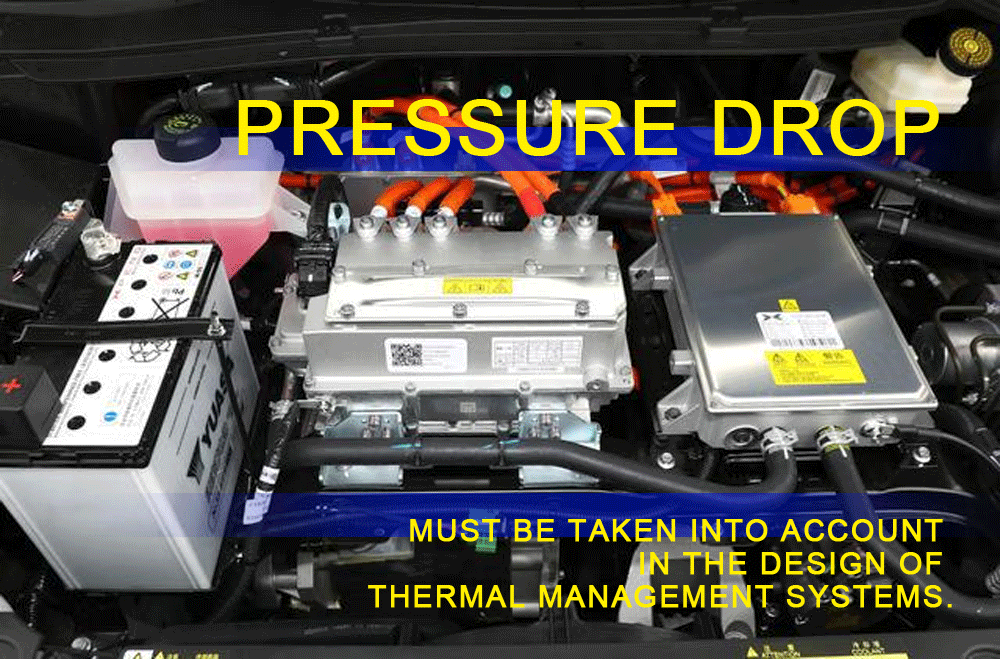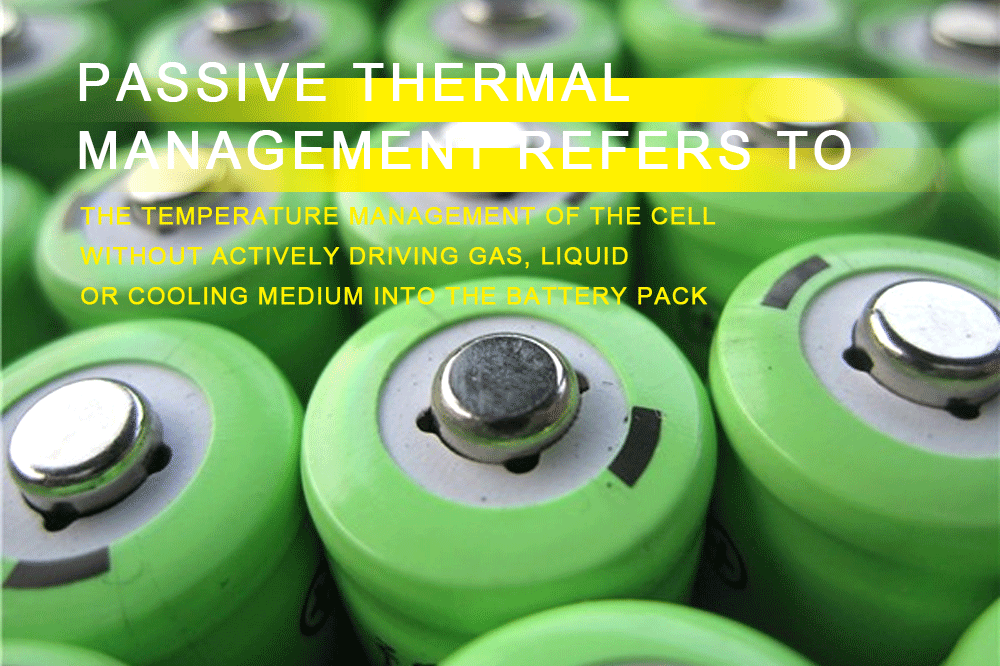Home » battery thermal management system » How does the battery’s thermal management system work?
How does the battery’s thermal management system work?
In previous articles, we mentioned the importance of a battery thermal management system and the cause of battery heating. But how does a thermal management system work? This article will cover this in detail. The battery thermal management system can be divided into active thermal management system and passive thermal management system, let’s have a look at their respective working principle.
Active thermal management system
Active thermal management involves using gases (including air), liquids or refrigerants to flow through all the cells in the battery to lower the temperature. Gas cooling and liquid cooling are commonly used at present.
Gas cooling
Gas cooling is the use of cooling gas directly through all the battery cells and electronic devices to reduce the temperature of the battery pack. Normally, a gas cooling system requires a fan, duct and heat exchange disc. The gas cooling system responds faster than the liquid cooling system and the daily mass is smaller, so the efficiency is relatively high. In addition, another advantage of the gas cooling system is that the cooled air can flow directly through the cell, without dead angle. The fault of gas cooling system is that the gas usually worse than liquid in heat absorption ability, it is easy to be in the process of flow batteries to heat, so the gas has low temperature near into position, and the temperature rise near out of position. Not only is the cooling effect of the cell in this position poor, but the temperature gradient formed in the channel through which the gas flows will directly cause the uneven temperature of the cell, which will lead to different aging rates of the cell and affect the life of the entire battery.
If ambient air is used as the cooling gas, we call it a passive air cooling system. It is slightly different from the active gas cooling system. On the one hand, the air needs to be filtered to avoid dust, water vapor and other pollution inside the battery pack. On the other hand, the cooling capacity is limited to reducing the temperature to the ambient temperature. For example, if the ambient temperature is 30℃, then the thermal management system can only cool the battery to 30 ℃, but usually active thermal management systems can switch between active and passive cooling modes.
Another challenge with gas cooling is the difficulty of system design, which conflicts with the need to seal the battery pack. The gas cooling system is usually an open system, which makes it difficult for the battery pack to meet the IP69 package standard. If the battery is inside the vehicle, building or container, the packaging problem is well solved, whereas if the battery is installed outside, it is difficult to solve.
Liquid cooling
Liquids are another common cooling medium for active thermal management systems, and are typically 50/50 mixtures of water and ethylene glycol, the same coolant used in engines. The system consists of a distribution system integrated into the battery pack, usually with a number of pipes and heat exchangers, and a number of heat exchange plates distributed on the surface of the battery cell. The advantage of liquid cooling system is that the cell heat can be transferred quickly and effectively. It can also serve as a heating system to provide heat flow in response to cold conditions in winter. The disadvantage of this system is that the mass is relatively heavy, and there is a risk of leakage. Because the liquid cooling system is a closed system, the packaging problem is easily solved for the battery pack installed in an external environment.
In a battery pack with a liquid cooling system, there are two ways to manage the heat from a lithium-ion cell. The first involves using well-conductive splints attached directly to the cell, and then running the cooling/heating liquid directly through the splints. The second method is to use a single splint to allow the fluid to flow through, with a series of cooling panels attached to the splint. Instead of laying directly on the panels, the cells are attached to these panels.
Another classification of thermal management systems is direct and indirect. Sometimes, direct cooling refers to the direct contact of the cooling/heating medium with the cell, while indirect cooling refers to the flow of the cooling/heating medium through the heat exchanger that is in direct contact with the cell. In practice, it is more feasible to use a direct air cooling system, where the thermal management system can be designed to push or pump air through the cell.
Coolant cooling systems
Coolant cooling systems are also a method of battery thermal management. Coolant systems have many of the advantages of liquid cooling systems, but the cost is high. On the plus side, of course, they eliminate the danger of liquids leaking from batteries. The Behr Group (now Mahler International GMBH) is a typical example of introducing coolant into the cooling system of batteries for hybrid and pure electric vehicles.
Heat pipes
For large energy storage systems, “heat pipes” have been discussed and evaluated for use in various types of lithium-ion battery thermal management systems, but there is still no good solution to balance performance and cost. In principle, heat pipes combine two thermodynamic principles to transfer heat: conduction and phase transition. A heat pipe is a metal tube with a special liquid inside. As the catheter is heated, the liquid inside evaporates into gas to the other end of the catheter, which is then returned to liquid under cooling conditions. Heat pipes are already used in portable computers, but not in cars or large energy storage devices. The biggest problem with heat pipes in cars is that the heat in a car’s battery pack is too high. When all the liquid is converted to gas and cannot be cooled in time, the system will stop converting heat.
Semiconductor cooler
Another thermal management device is a semiconductor cooler, the Peltier device. The Partie device is non-mechanical and consists of two different types of materials. When an electric current flows in from one end of the device, heat is transferred from one end to the other, and this thermal synergy helps the battery transfer heat. This mode of operation is the hybrid heat management system mentioned earlier. The hybrid thermal management system consists of different types of media, such as liquid, air, and other cooling media, combined with the battery system. For example, an electric fan can be enclosed inside a battery or module to circulate air inside the battery, which can be combined with a heat exchanger (such as an aluminum support pipe or a Partie device) to allow air to flow over the surface. The cooling liquid is all on the outside of the battery, and the heat transfer equipment cools the gas circulating inside the battery.
Pressure drop
Pressure drop must be taken into account in the design of thermal management systems. The pressure of the fluid is different where it enters and exits. The fluid can be either liquid or gas, and measuring the amount of pressure that the system has to overcome ensures continuous flow of the fluid through the cooling system. In a liquid cooling system, the pressure drop determines the size of the selected pump and the speed at which the fluid flows, which ensures that the fluid passes through the cooling system. In a gas cooling system, the pressure drop can be selected by selecting the fan size and the flow rate to ensure that the gas flows through the system.
Passive thermal management system
Passive thermal management refers to the temperature management of the cell without actively driving gas, liquid or cooling medium into the battery pack. Passive thermal management can be accomplished in a number of ways.
Use the outer packaging of the battery
A commonly used passive thermal management is to use the outer packaging of the battery to conduct heat conduction and heat dissipation, that is, the aluminum or stainless steel shell packaging is used to efficiently transfer the heat of the cell to the battery shell, and then radiate the heat to the environment. This passive thermal management is effective for batteries with low discharge rates because they produce less heat and heat at a slower rate.
Use the heat sink
Another passive cooling design uses the heat sink to dissipate the heat generated by the battery, and then uses the natural air flow generated by the car to passively flow through the heat sink to cool the battery.
Use phase change material
In addition, another passive cooling method is to use Phase Change Material (PCM). Phase Change Material refers to the Material that absorbs heat within a certain temperature range and then changes Phase. Although Phase Change is not only solid-liquid transformation, Phase Change endothermic is generally used to Change from solid Phase to liquid Phase. Or more precisely, from the solid phase to the soft phase. In these designs, a PCM is typically a solid material, such as paraffin wax or graphite, that can be inserted into a cell. As the cell heats up, the PCM absorbs heat and becomes soft or molten. PCM is a good cooling method because it can absorb a lot of heat through phase transitions and is relatively cost-effective. But the material has a maximum working temperature beyond which it melts completely and can no longer absorb heat.
Pros and cons of passive thermal management systems
The biggest advantage of passive thermal management systems is low cost, as there is no additional heat exchange hardware; The disadvantage is that the response is relatively slow, the cooling speed is related to the ambient temperature, and the cell temperature can only be reduced to the ambient temperature.
Temperature protection and insulation
Another aspect of the thermal management system is the integration of heat insulation panels within the focus area, which aims to transfer and equalize heat from the external and internal components. Depending on the design of the energy storage system, installation location and heat generation, it may be necessary to add some steel plates or aluminum to prevent radiant heat and steer it away from lithium-ion batteries. There are also more advanced insulation panels with sandwich designs in which two metal plates are separated by insulating material to separate heat from specific parts of the system.
In some systems, the battery casing itself can act as a heat shield without the need for additional heat shielding. Often used to keep battery heat in and out of the module housing, thermal insulation can be used. Thermal insulators are used in these systems for two reasons. In summer and hot environments, it can be used to protect the battery from excessive ambient temperatures. Used in cold areas or in winter, it can be used to avoid heat loss. But even in these systems, electronics need to be protected from battery heat.
Thermocouple and measurement
Temperature measurement is the key technology in the design and management of thermal management system. Because the thermal conductivity of lithium ion cell is not good, and the purpose of temperature management is to control the temperature of the cell, so theoretically the best position of the true temperature inside lithium ion cell is inside the cell. However, it is very difficult to install a temperature sensor inside a battery, even if it is incorporated into a cell design, but the resulting safety risks and increased manufacturing costs mean that such a design should be used at best for research rather than mass production. Therefore, the temperature measured by the battery pack thermal management system is actually the surface temperature of the battery cell.
The position and number of installed temperature sensors
Temperature sensors are usually installed in three locations of the cell: near the terminal, in the center of the surface, and farthest from the terminal. A photothermistor can be a significant cost in a practical thermal management system if the temperature of each cell is measured at three locations. As a result, two or three temperature sensors are typically assembled per module in roughly the same locations as they are installed to measure cell temperature: one on the first cell of the module, one in the middle of the module, and one at the very end of the module. Of course, how many sensors to install and where to install them are the most appropriate questions in module design, which need to be determined by module characterization tests and CFD simulation analysis.

The function of temperature sensor
The temperature sensor is an important component of the Thermal Management System (TMS). For example, it monitors the temperature of battery strings. When the temperature is too high or too low, the temperature sensor communicates with the BMS. In addition, liquid and air cooling designs also require temperature sensors to monitor the temperature of the liquid (or gas) coming in and the temperature of the liquid (or gas) going out. In this case, the temperature sensor needs to be installed in the flash of the battery string.
Generally speaking, the external ambient temperature is different from the internal temperature of the energy system. Many specifications state that the system can operate in a temperature range of 0 to 70 ° C, not the temperature that can be reached inside the battery, but the temperature of the external environment in which the battery operates. The thermal management system must keep the lithium ion cell at an appropriate operating temperature. Therefore, for higher temperature environment, pre-cold air or refrigerant cooling system needs to reduce the temperature of the cell to about 23; In colder climates, heaters are needed to provide warm gas or liquid into the battery pack to raise the operating temperature of the battery.
Two types of temperature sensors
Battery systems typically use two types of temperature sensors: Thermocouples (TC) and Negaive Theral Coficients (NTC), which measure temperature through two pieces of metal with one or more contact points. A voltage is generated when the two pieces of metal are at different temperatures, in the same way that Peltir works. Thermocouple measurement temperature range is relatively wide, is -180~1800℃, while the measurement range is usually used is 0~1100℃.
Negative temperature coefficient
Negative temperature coefficient (NTC) The resistance value of thermistor decreases with increasing temperature. NTC resistors can normally be tested in the temperature range of -50 ℃ to 150℃, but for some special NTC resistors, such as glass-coated NTC cells can operate at 300℃. Temperature range, durability, cost, stability and yield are important criteria for battery pack thermal management system selection.

























